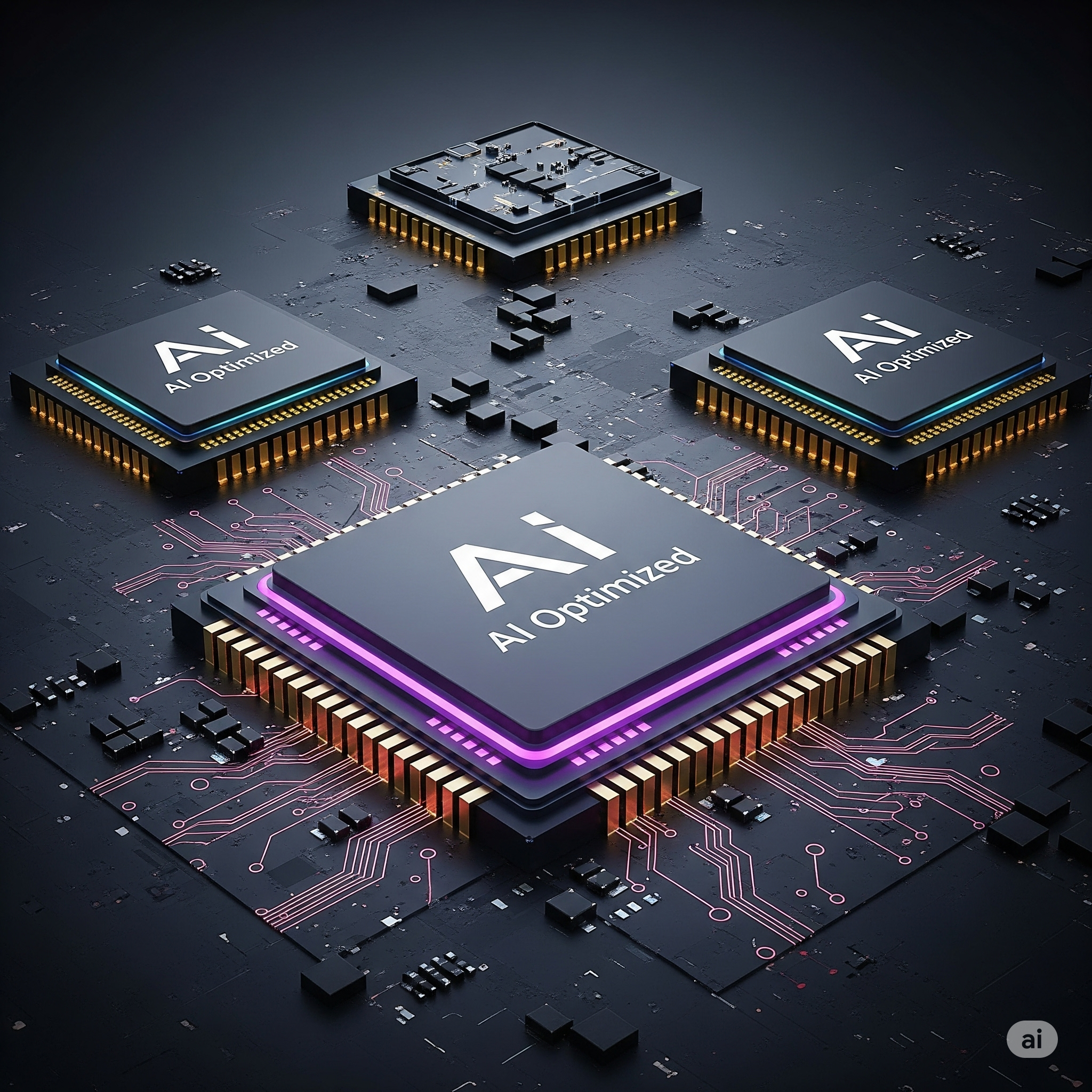Introduction
Artificial Intelligence (AI) has emerged as a transformative technology reshaping industries, from healthcare to finance, autonomous vehicles to smart devices. To realize the full potential of AI applications, powerful and specialized hardware is essential. This is where AI-optimized chipsets come into play. These chipsets are designed specifically to accelerate AI workloads, offering superior performance, energy efficiency, and speed compared to conventional processors.
This article explores the fundamentals of AI-optimized chipsets, their architecture, working principles, benefits, challenges, and real-world applications, providing an educational overview suitable for students, researchers, and technology enthusiasts.
What Are AI-Optimized Chipsets?
AI-optimized chipsets refer to specialized semiconductor chips engineered to efficiently handle the complex mathematical operations and data processing tasks involved in AI and machine learning algorithms. Unlike general-purpose CPUs (Central Processing Units), these chipsets are tailored for AI-specific computations such as matrix multiplications, tensor operations, and neural network inference.
Common types of AI-optimized chipsets include:
- Graphics Processing Units (GPUs)
- Tensor Processing Units (TPUs)
- Neural Processing Units (NPUs)
- Field Programmable Gate Arrays (FPGAs)
- Application-Specific Integrated Circuits (ASICs)
Each of these chipsets offers unique advantages depending on the AI task and application context.
Historical Context and Evolution
The need for AI-optimized hardware became prominent as AI models grew in complexity and data volumes exploded. Initially, AI computations were performed on traditional CPUs, which were inefficient for such parallel workloads. GPUs, originally designed for rendering graphics, were repurposed for AI due to their parallel processing capabilities.
Following GPUs, companies like Google introduced TPUs designed specifically for neural network processing. Subsequently, NPUs and ASICs were developed for even more efficient and customized AI computations.
Architecture of AI-Optimized Chipsets
1. Parallel Processing Units
AI workloads involve massive parallelism — performing many calculations simultaneously. AI chipsets incorporate thousands of cores or processing elements designed to execute parallel computations efficiently.
2. Matrix and Tensor Operations
AI computations heavily rely on matrix multiplications and tensor processing. AI chipsets have dedicated hardware blocks to accelerate these operations at high throughput.
3. High Bandwidth Memory
Data access speed is critical. AI chipsets use high-bandwidth memory technologies like HBM (High Bandwidth Memory) to rapidly feed data into processors.
4. Low Precision Arithmetic
AI models often tolerate lower precision (such as 16-bit or 8-bit floating-point) without loss in accuracy. AI chipsets utilize specialized arithmetic units optimized for low-precision computation, enhancing speed and reducing power consumption.
5. On-chip Neural Network Accelerators
Some chipsets integrate dedicated neural network accelerators that handle layers of deep learning models, improving inference speed and efficiency.
How Do AI-Optimized Chipsets Work?
AI-optimized chipsets accelerate key operations in AI workflows such as:
- Training: Adjusting AI models using large datasets to minimize errors.
- Inference: Applying trained models to new data to make predictions.
They speed up operations like convolution, activation functions, and matrix multiplication by distributing tasks across many cores and using specialized hardware blocks. The chipset communicates with system memory and storage to process input data and produce output rapidly.
Advantages of AI-Optimized Chipsets
1. Improved Performance
AI chipsets deliver orders of magnitude faster processing for AI tasks than general-purpose CPUs.
2. Energy Efficiency
By tailoring computation to AI needs and using low-precision arithmetic, these chipsets consume less power.
3. Reduced Latency
In applications like autonomous vehicles or robotics, real-time processing is crucial. AI-optimized chipsets provide low latency for immediate decision-making.
4. Scalability
AI chipsets support scaling from edge devices with limited resources to massive data centers performing large-scale AI training.
5. Specialized Functionality
They provide hardware support for specific AI functions, such as sparse matrix multiplication or quantized neural networks, optimizing overall system efficiency.
Challenges and Limitations
1. Complexity of Design
Designing AI-optimized chipsets requires deep expertise in both hardware engineering and AI algorithms.
2. Cost
Custom AI hardware development and manufacturing can be expensive, limiting accessibility.
3. Compatibility
Some AI workloads and frameworks may not fully utilize specialized chipsets without significant software optimization.
4. Rapid Evolution
AI models and algorithms evolve quickly, risking hardware obsolescence.
Applications of AI-Optimized Chipsets
1. Autonomous Vehicles
AI chipsets process sensor data in real-time for navigation, obstacle detection, and decision-making.
2. Healthcare
AI hardware accelerates medical imaging analysis, drug discovery simulations, and genomics.
3. Smartphones and Edge Devices
Embedded AI chipsets enable on-device voice recognition, image processing, and augmented reality.
4. Data Centers and Cloud Computing
Large-scale AI training and inference tasks leverage AI-optimized chipsets for efficiency.
5. Robotics and Industrial Automation
AI hardware supports intelligent automation, quality control, and predictive maintenance.
Future Trends in AI-Optimized Chipsets
1. Integration with Quantum Computing
Hybrid chips combining classical AI hardware with quantum processors may emerge.
2. Neuromorphic Chips
Chips modeled after the human brain, capable of more brain-like computations.
3. Increased Customization
More application-specific AI chips tailored to particular industries.
4. Improved Software Ecosystems
Better AI frameworks and libraries optimized for hardware to simplify development.
5. Energy Harvesting and Sustainability
Focus on low-power AI chips to reduce environmental impact.
Conclusion
AI-optimized chipsets are the cornerstone of modern intelligent computing systems. They transform how AI models are trained and deployed, enabling breakthroughs across industries by providing unprecedented computational power, energy efficiency, and real-time processing capabilities.
Understanding these chipsets is crucial for anyone interested in AI, hardware engineering, or the future of technology. As AI applications continue to grow, the evolution of AI-optimized chipsets will be pivotal in driving innovation and efficiency.
Summary Points
Future trends focus on hybrid quantum integration, neuromorphic chips, and sustainability.
AI-optimized chipsets are specialized hardware designed for efficient AI computation.
Types include GPUs, TPUs, NPUs, FPGAs, and ASICs.
These chipsets feature parallel processing units, specialized arithmetic, and high-bandwidth memory.
Advantages include faster processing, lower power consumption, and real-time responsiveness.
Challenges include design complexity, cost, and evolving AI algorithms.
Applications span autonomous vehicles, healthcare, edge devices, cloud AI, and robotics.




